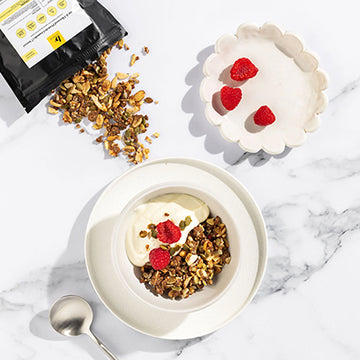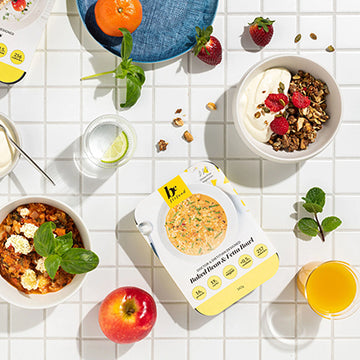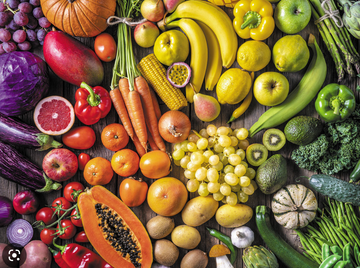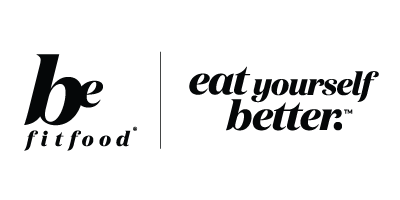Cravings are not always a result of the body lacking a certain nutrient or low blood sugar. It is common for the body to prepare itself for certain foods at specific times due to previous routines, resulting in cravings which can lead to overeating and weight gain due to eating when the body isn’t necessarily hungry. [1] There are many reasons that cravings may occur which include low nutrient intake, poor sleep routine or consuming high quantities of palatable foods.
People who have busy lifestyles sometimes find it hard to consume adequate nutritional meals, and instead often have coffee or carbohydrates for fuel as it is most convenient to them. [2] However, these types of food can only keep the body full for so long, and therefore cravings can often occur. [2] Reducing these types of cravings can be done through consuming a balanced diet with a variety of food groups including lean meats, wholegrains, vegetables, fruits and dairy.
Lack of sleep can sometimes influence how hungry we are, and poor sleep quality can lead to cravings for certain foods, especially sweets. [3] This is due to sleep deprivation leading to an increased production of Ghrelin, which is also known as the hunger hormone, causing the body to eat more as it feels hungry, even when it isn’t. [3]
Consumption of sugary foods causes an insulin response resulting in a rise to our blood sugar levels which usually results in an instant boost to our energy and happiness levels. [1] However, this feeling doesn’t last for long as the blood sugar levels soon dramatically decrease leaving the body as hungry as it initially was. [1] This leads to the body craving more sugary food to experience this same sense of satisfaction. [1]
Tips to Manage and Reduce Cravings
-
Removing Temptation Foods and Keep Healthy Foods on Hand Instead
Studies have shown people are more likely to snack on foods that are within arm's reach compared to when they are 6 meters away. [4] Therefore, by removing temptation foods from your surroundings, you can decrease cravings for foods when you aren’t necessarily hunger reducing the risk of overeating. However, if cravings do occur, try to have nutritious foods accessible, such as fruits and vegetables, instead of energy dense foods such as chocolate or lollies. Studies have found that people how keep fruit on their kitchen bench instead of lollies, have a lower BMI. [5]
-
Consuming for Low GI Foods
Low GI foods such as beans, fruit, pasta, multigrain bread and porridge, all allow for slow digestion in the body. This allows the body to feel fuller for longer through a slower rise and fall of blood sugar levels. [6]
-
Plan Meals Ahead of Time
Planning meals and snacks ahead of time can also reduce cravings as the body is being provided with all its required nutrients, leaving the body feeling satisfied and fuller for longer. Planning meals also allows you to prepare a balanced plate of food accessible to you, reducing the risk of snacking on energy dense foods that won’t fill you up, leading to overeating. [7]
-
Stay Hydrated
Adequate water intake is also a factor in reducing the risk of experiencing cravings and overeating. Staying hydrated is important in transporting nutrients leading to the body feeling fuller for longer. Water also plays a major role in controlling appetite, and therefore staying hydrated can reduce cravings as well as overeating. [8]
Cravings are likely to occur if you start a new diet as your body has to adjust to a new nutrition routine and new portion sizes. If you are extra hungry whilst consuming the Be Fit Food meals, you are able to add on some recommended extras to bulk up your meal to keep you fuller for longer. For example, this could be 1 cup of cooked vegetables or 2 cups of leafy vegetables. The full recommended extras guide can be found on the Be Fit Food website.
For more information regarding cravings, overeating and the recommended extras guide, please feel free to book a consultation with one of our Accredited Practicing Dietitians at Be Fit Food.
References
- Meule A. The Psychology of Food Cravings: the Role of Food Deprivation. Current Nutrition Reports. 2020;9(3):251-257.
- Pelletier JE, Laska MN. Balancing healthy meals and busy lives: associations between work, school, and family responsibilities and perceived time constraints among young adults. Journal of nutrition education and behavior. 2012 Nov 1;44(6):481-9.
- Schmid S, Hallschmin M, Jauch-Chara K, Born J, Schultes B. A single night of sleep deprivation increases ghrelin levels and feelings of hunger in normal-weight healthy men. Journal of Sleep Research. 2008;17(3):331-334.
- Langlet B, Fagerberg P, Glossner A, Ioakimidis I. Objective quantification of the food proximity effect on grapes, chocolate and cracker consumption in a Swedish high school. A temporal analysis. Plos one. 2017 Aug 10;12(8):e0182172.
- Wansink B, Hanks AS, Kaipainen K. Slim by design: kitchen counter correlates of obesity. Health Education & Behavior. 2016 Oct;43(5):552-8.
- Ball SD, Keller KR, Moyer-Mileur LJ, Ding YW, Donaldson D, Jackson WD. Prolongation of satiety after low versus moderately high glycemic index meals in obese adolescents. Pediatrics. 2003 Mar;111(3):488-94.
- Rebello CJ, Liu AG, Greenway FL, Dhurandhar NV. Dietary strategies to increase satiety. Advances in food and nutrition research. 2013 Jan 1;69:105-82.
- Jeong JN. Effect of pre-meal water consumption on energy intake and satiety in non-obese young adults. Clinical nutrition research. 2018 Oct 1;7(4):291-6.









